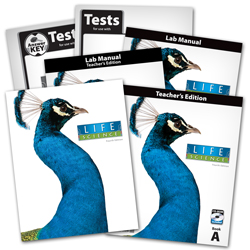BJU Press's Life Science, Fourth Edition is intended for use with junior high students. It covers many topics also covered in high school biology but at less challenging levels. It is published in a softcover textbook with more than 500 pages.
It begins with a discussion of the nature of science and the uniqueness of a Christian approach to science. It then teaches life science, beginning at the cellular level and gradually shifting to larger life forms. The first two units (of the course’s six units) teach largely about cells, covering topics such as cell membranes, types of cells, parts of cells, cellular respiration, photosynthesis, cell division and genes, genetics, and genetic changes and biotechnology. The next unit covers the classification kingdoms of archaebacteria, eubacteria, protista, and fungi as well as plants. The last three units address the animal kingdom, the environment and ecosystems, and the human body respectively.
While animal reproduction is covered in the text, human reproduction is treated in a special chapter (Chapter 24) contained only within the teacher's edition. This allows the parent or teacher to decide whether or not to use it.
The course has a strong Christian perspective, promoting a literal interpretation of Scripture, a belief in Creationism, critiques of evolution, the sanctity of life, and other Christian positions.
In contrast to most high school level texts, this course has full-color illustrations on just about every page. Nevertheless, the content is appropriately challenging for junior high students.
Each chapter includes “sidebar” boxes with enrichment content. Special topics are addressed at length in “Facets” and “Thinking Critically” boxes. The latter include activities and questions that require critical thinking skills. “Connection in Science” boxes make cross-curricular connections to history, literature, and math. “Bible Integration” boxes present biblical principles in relation to science. “Think About It” boxes challenge students with brief, thought-provoking questions. “Fascinating Facts” boxes are self-explanatory.
Within each chapter are a number of section review question sets in addition to chapter review sections at the end of each chapter. The chapter reviews, titled “Putting It All Together,” begin with a list of the key terms for students to review and a bullet list of the main points taught in the chapter. The rest of the chapter review presents questions in different formats. “Sorting the Data” questions check on comprehension of the chapter’s content. “Outside the Lab” assignments have students do research, writing, or drawing. For example, students are told to construct a concept map of photosynthesis on page 89 and “Write a transcript for an imaginary interview with a creationist and with an evolutionist” on page 179. “Analyzing the Data” questions challenge students to apply higher-level thinking skills in questions based on the concepts taught in the chapter. “Drawing Conclusions” requires students to summarize the main points of the chapter in three to five sentences. Chapter reviews conclude with a set of “Standardized-Test Prep Questions.” Test packets with chapter tests as well as their companion keys are available separately. The text includes an extensive glossary and an index.
The teacher's edition (published in two volumes) includes the Teacher’s Toolkit CD-ROM in the back of the first volume . The Teacher’s Toolkit has visual aids for the course, quizzes and their answer keys for each chapter, a crossword puzzle (and key) for each chapter, and “extra content” with data charts, additional field investigations, and other resources that you might want to use.
The teacher’s edition has slightly-reduced images of student pages with answers, marginal notes, lesson presentation suggestions, hands-on learning activities, icons showing when to use visuals or animations from the Teacher’s Toolkit CD-ROM, and helpful weblinks. Scheduling for Lab Manual pages is at the beginning of each chapter in the teacher’s edition.
The Life Science Lab Manual is an essential component of this course. This 374-page book includes both “applications” and “investigations.” Applications are activity pages for written work. They might require activities such as answering multiple-choice or matching questions, completing charts, filling in blanks, writing sentences, completing graphic organizers, solving puzzles, and drawing. Investigations in the Lab Manual are of four types: class, research, field, and personal. Some class investigations such as observing the growth of plant seedlings can easily be done by students at home. However, many class investigations use scientific equipment such as a balance, beakers, clamps, graduated cylinders, slides, tubes, and a ring stand. The extensive list of required supplies includes household items as well specialized items like Benedict’s solution, bluret solution, a cow heart, dissection tools, amoeba (living culture), and both irradiated and nonirraditated seeds. There isn’t time to complete every activity and investigation, so plan in advance which ones are most practical. The Lab Kit for BJU Press Life Science 7 ($132.50) includes many of the items needed for lab work, although it does not include a microscope or live cultures or basic household items.
The Life Science Subject Kit includes the student text, the teacher's edition, the lab manual, the lab manual teacher’s edition, a packet of tests, and the tests answer key. You might find the chapter review material combined with the quizzes on the Teacher's Toolkit CD-ROM sufficient for assessment without using the test packet.










